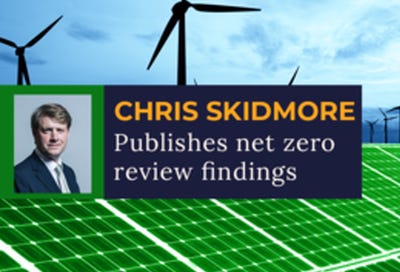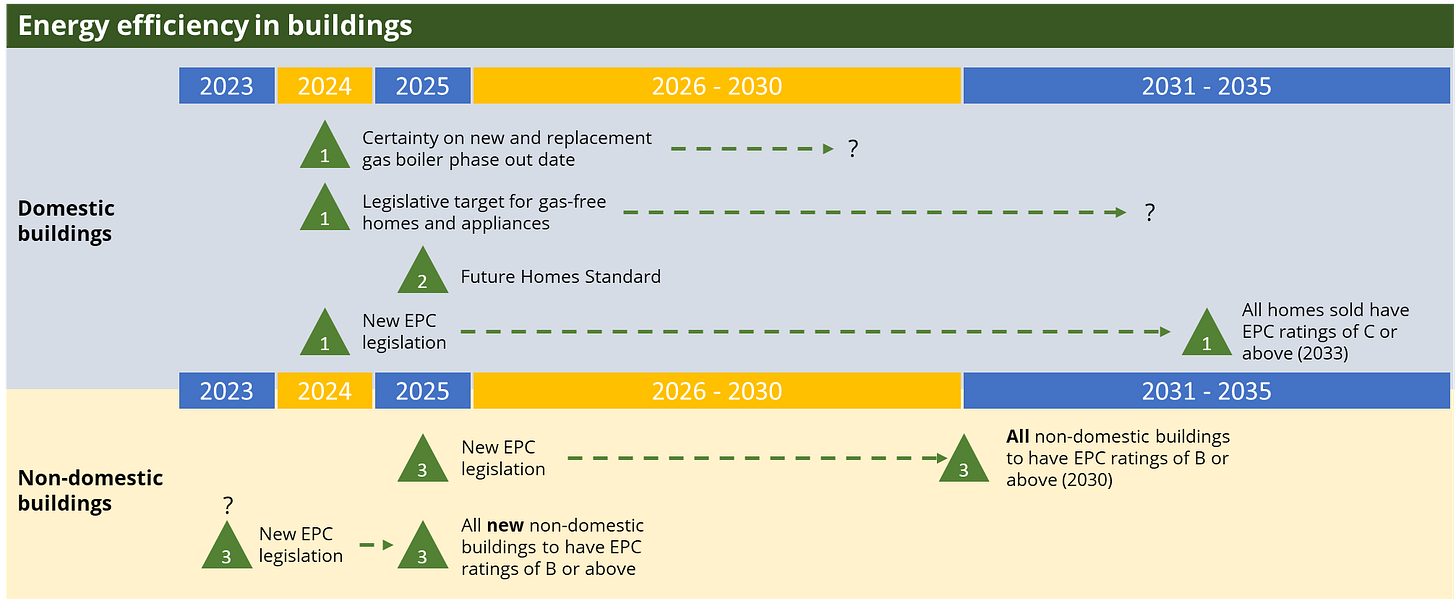Charting 25 for 2025
The Skidmore Report is here and we've been looking at some of its immediate priorities.
The Review’s evidence points towards some basic principles of effective net zero decision making. We must:
Quickly take the decisions we know we have to;
Invest in research and development;
Prepare the ground with agile and flexible policy frameworks.
Adapted from Mission Zero (Skidmore Report), HM Gov, January 2023
In our opinion, if anything good came out of the mini-budget in September 2022 – even indirectly – it was Chris Skidmore’s Review of Net Zero, the report from which came out a couple of weeks ago. The Skidmore team has done a creditable job; bringing together 1,800 submissions and inputs from 50 open public consultations into a coherent set of outputs1 in such a short space of time is a mammoth task. A few more graphics would not have gone amiss but that would be quibbling.
The report highlights the need for national leadership, focus and coordination under a single, multi-departmental body. Only by doing this and setting something up to span successive governments up to (and even beyond) 2050 - a little like the terms under which IFaTE was created, for example – can the longer term policies be consistently pursued. With our skills hats on, we’d stick the Green Jobs Delivery Group in there from the off.
Well and good for central government. But the report also acknowledges the vital role of ‘local’ in delivering Net Zero. We’ve seen this point powerfully argued by UK100 and we’d like to think Chris has been reading and listening to The Green Edge on this point. We know some of his team certainly do and we’re proud to have them among our subscribers.
As we’ve already been told plenty of times, Skidmore affirms that Net Zero delivery is cost effective as well as being a great economic and social opportunity – but only if we stay ahead of the curve. As it stands, he says, it needs greater momentum and urgency. And it needs to be data-driven; robust data will help to plan and monitor progress at all spatial levels, a point well made by the Green Jobs Taskforce all the way back in July 2021.
The Skidmore report makes some 129 recommendations, which we aren’t going to regurgitate here. But we did think it might be useful to chart out his ‘25 key actions for 2025’2 and group them in a way that makes sense to us.3
Feel free to download the graphics if you feel they might be useful. We’ve also glued them all into a single infographic at the end of this post.
Skidmore’s 25 key actions for 2025
Energy efficiency in buildings
Hard dates in the recommendations are very welcome and much needed, but we think they should be even more aggressive.
In particular, we’d like to see new build regulations and the planning system being made to push every opportunity for decarbonising domestic property. A key part of this is having a trusted, effective advisory system; a BEIS pilot demonstration project has already shown how small expert groups can help domestic homeowners decide and plan for themselves.
Big contributors here are companies like Octopus Energy and British Gas, who are leading the charge to reduce the cost of heat pumps. Their plans and investment should be factored into central and local government planning, we feel.
Economy, business and industry
We’ve grouped a bunch of recommendations here, including CCUS, circular economy, carbon markets, and R&D. Together they represent huge scope for accelerating the current rate of investment in net zero-focused technology, perhaps by special treatment of write-off rates and the profits generated.
We feel there’s also much value to be gained in extending the current frameworks and standards for financial reporting to include green disclosure, measurement and reporting. This would push businesses towards managing and valuing their carbon legacy and wider assets going forward.
Actions in this section will also influence how major investment houses and pension funds might change their approach to making investment decisions, potentially pushing more funds into green investment. And moving this whole area forward at speed will also help show the scale of the insurance policies we need in the form of carbon offsets, and how best to ensure the market in carbon offsets (ETS) works well, reliably and with integrity.
The update to the Green Finance Strategy should be a good start to all this (recommendation 6). But hang on, it’s late. Come on chaps!
Energy - clean, secure and affordable
A clear net zero roadmap for energy over an extended period is a critical first step towards focusing investment and developing the skillbase. Geographies need to be recognised and aligned with Levelling Up and the forthcoming Local Skills Improvement Plans (LSIPs). Also, given the scale and contentious nature of some of the investments required there needs to be a speedy way to resolve local challenges to national priorities.
We note that some of the recommended actions in this section tend to be a little along the lines of arm-waving, without having hard milestones attached. We’d like to see those tightened down.
Transport
We confess to being a little surprised at seeing only one recommendation in the 25-for-2025 being related to transport. Perhaps Chris thinks transport is doing just fine as it is in the short term; we do note here that over 40 of the current round of Levelling-Up projects are transport focused, so he may be correct.
Don’t lose sight of this though. The continued growth of EVs raises the obvious challenge of installing the public charging infrastructure. And don’t forget public transport and trucking, which will require different infrastructures, including hybrid technologies and hydrogen.
Land use and climate
We prefer the term Land use here over the report’s pigeonhole of Food, agriculture and nature, to recognise that land use, land use change and forestry (LULUCF) is not just a DEFRA thing. In our view, it’s just as much owned by BEIS, DLUHC, DfT and others to roadmap how the UK can shift ‘traditional’ agricultural land towards an increasing number of alternative uses: new foodstuffs, biomass, and other forms of energy generation, to name a few.
Do we require a rural version of the North Sea Transition Authority to handle this change? If so, it would need to factor in a whole range of other things: nature-based solutions to the climate emergency like peatland restoration and management, forestry planting and harvesting; timber for construction; the circular economy; and others.
Local, regional and individuals
A basic principle highlighted in the Skidmore Report is to ‘quickly take the decisions we know we have to.’ In case that principle isn’t being properly understood, recommendation 21 is ‘reform the local planning system and the National Planning Policy Framework now’. Now! That should do the trick.
As we said earlier in this post, highlighting ‘local’ and the importance of the spatial aspect of net zero are important contributions from the Skidmore Review to the national debate. Capacity building in local bodies is critical to deliver Net Zero: in domestic decarbonisation; in education and training; and in capitalising on local opportunities to leverage the green economy.
And holding up this whole pyramid are the British people themselves. We’re pleased to see that the Skidmore Report has recognised the need for a broader citizen engagement and education programme to (hopefully) inform the millions of individual decisions that will be taken by individuals in changing their homes, their vehicles and their lifestyles to create a Net Zero world. This, perhaps, will be the biggest ask of all.
The Skidmore Report has seven key conclusions, ten priority missions, six pillars, and 129 recommendations.
We do sometimes wonder why everything government does is sloganized like this. There are more than 25 recommendations in this list, but we guess any other number just wouldn’t have the same ring to it.
In our charts, the numbers in the actions and milestones relate them back to the recommendation numbers in the Skidmore Report.











